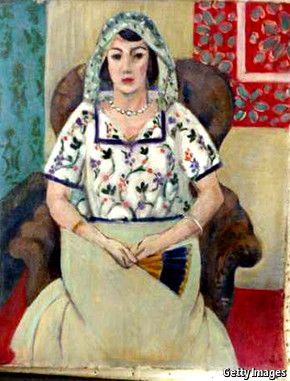News:
The Munich art haul: In the shadow of the Holocaust
ONE day Hollywood will spin its yarns around Cornelius Gurlitt, the eccentric 80-year-old recluse who lived quietly for decades in a drab Munich flat amid towers of canned food and 1,406 stunning works of art. But first lawyers, diplomats and the descendants of Jews and other victims of the Nazis need their questions answered. The most pressing is what to do with Mr Gurlitt’s art now.

She was part of the Gurlitt stash
Mr Gurlitt’s case has become an international controversy since it was revealed on November 3rd. In a routine investigation, Bavarian prosecutors had entered his flat in February 2012 and found works by Matisse (pictured), Chagall, Beckmann, Nolde, Picasso and other masters. Many of the paintings appear to be among those the Nazis once confiscated from German museums as “degenerate art”. Others probably belonged to Jews or other private owners whom the Nazis robbed. With their provenance unclear, the investigators kept the art but did not make their discovery public until this month.
They may have violated Mr Gurlitt’s legal rights. He has not so far been accused of any crime. The prosecutor’s office says that it may only investigate its original case of tax evasion. Whether the prosecutor was within his remit to hold paintings unconnected with this allegation is questionable. He will now return a first batch of several hundred paintings whose ownership by Mr Gurlitt is uncontested.
Such legalism misses the point, say others, including Jewish groups. The prosecutor should have made all the art public much sooner so that victims of the Nazis or their descendants could have a look. Moreover, they say, this matter is at heart about the Holocaust and therefore not only legal but also political and moral, and should be handled by the German government.
The government has now appointed a task force to research the art’s provenance. Piece by piece, it is uploading more of it to www.lostart.de, a site where victims or heirs can find works that are rightfully theirs. But that is an ad hoc solution. What the Gurlitt case has exposed is that Germany does not yet have a comprehensive answer to the problem of looted art.
In 1998 Germany and 43 other countries signed the Washington Principles pledging to search their public collections for looted art in order to restitute it. But that does not cover cases of “degenerate art”, which the Nazis took out of state-owned German museums under a 1938 law, which Germany has, amazingly, never officially annulled. Nor does it cover private stashes such as Mr Gurlitt’s.
Whatever Germany does now, Mr Gurlitt’s case remains vexing. His father, Hildebrand, was one of four traders the Nazis commissioned to deal in “degenerate” or looted art, which makes the provenance of at least some of it questionable. After his death in 1956, his wife told at least one big lie, claiming that the collection was destroyed in the Dresden firebombing.
Mr Gurlitt inherited it in 1967. He may thus be saved by a statute of limitations of 30 years, although the attorney-general of Bavaria is now studying whether this can be lifted retroactively. An alternative would be to prove that Mr Gurlitt inherited the works “in bad faith”, in which case he never properly owned them in the first place. Better still, Mr Gurlitt could voluntarily begin co-operating in the search for a solution.


